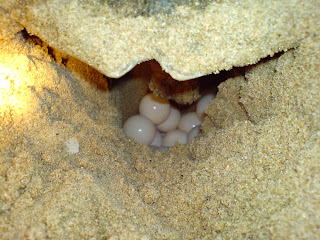 I went on my first turtle walks this
I went on my first turtle walks thisSaturday and Sunday mornings (Friday and Saturday late nights). in case you don't know, what people do during turtle walks is collect turtle eggs which are laid by turtles during high tides in the night and then relocate them to a safer location away from public beaches and people in an enclosed hatchery. a turtle can lay up to 200 eggs at once in a single nest. if left untouched usually not even a single one may hatch and reach the shore safeThis weekend i went for my first turtle walks only. its because the beaches around the cities usually have too bright lights and when the turtles hatch and dig themselves out of the nest, the little ones get confused with the bright lights and start walking in opposite direction from the shore and end up away from the beach even on roads. most of them would be easily discovered by dogs because of their smell and become food and so decreasing the chances of survival even more. infact on day 2 we found a nest which was discovered by dogs before we reached and we found only 38 eggs and several broken ones. the footmarks left by the dogs proved it all.

The species of turtles that lay eggs near the beach of my city are endangered, Olive Ridley turtles, who get their name from the olive coloured back which these beautiful sea creatures have. the person who co-ordinates these turtle walks (Mr. Arun) has been doing this from 30 years. although these turtles are at the top of the food chain, we are finding so many of them dead washed ashore, almost all caused by some kind off unnatural end. most of them die because of sea trawlers' nets in which they get entangled in, and then get dragged for a long time with their boats, unable to come up and breathe for too long, they ultimately end up drowning. we found 7 dead turtles in two days i went for the turtle walks which was too sad sight to watch. one was even bleeding from its tail when we found it dead and another had its head chopped off! its just too sad to watch.
On day 2 we found two olive ridley turtles nesting and laying eggs and saw the whole process happening in front of us. Arun said some people walk for years and don't get to see a turtle nesting and here i was seeing two on my second day, talk about being lucky. the turtles lay the eggs about 10 to 15 meters from the high tide line in a foot or two deep nest beneath the sand which they dig with their fins. then she starts laying the eggs for about 45 minutes. after she finishes she beautifully covers the nests and dances over it compacting it and then camouflages it completely by throwing sand on it. its just amazing to watch her beautifully cover the whole nest as if nothing happened. after she leaves the place and goes back to the sea we dig up the nest and keep the eggs in a soft bag, make measurements of the nest and distance from the high tide line and then continue walking and searching for more nests. by the time we reach the end of the walk it became 0330hrs and we had reached the hatchery. where we dug up sand and replicate the nests dug by the turtles and slowly place all the eggs from the bags into the nests we made.
more information about turtles and joining for turtle walks in Chennai visit Students Sea Turtle Conservation Network's website.or contact Arun - 2490 1019 or Akila - 9940 300200, email sstcnchennai{AT}gmail{DOT}com.


2 comments:
I've only seen these in Discovery channel!! To think you've had a personal experience.. now that's really wonderful!!
Hi Vivek, I would like to use your photos of Olive Ridley Turtles and their eggs and nesting for an article we are carrying in the newspaper, DNA. I will give you image credit for the same. Please mail them to me on poojabhula@gmail.com and feel free to ask me any queries for the same. Regards,
Pooja Bhula
Feature Writer and Copy Editor
Zee Media Corporation
Post a Comment